A day of coring
Gerhard Behrens |
| Yesterday, I wrote that Monday’s big news was the helicopter operation to Pond Inlet. The next thing to catch everyone’s attention was the coring part of our cruise. I hope you remember that a core is when the workers drive a long, steel pipe into the bottom of the ocean and bring back a big tube of dirt. The coring team worked from Monday, around midnight, until Tuesday, around midnight: 24 hours of work! |
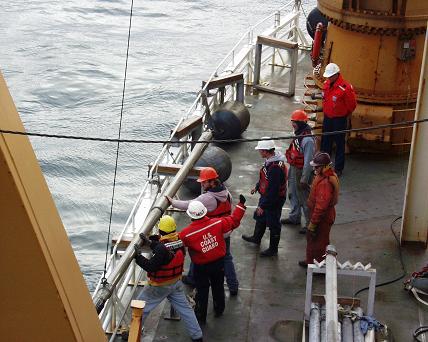
A team of people gets the core ready on the deck. |

A lot of cables and cranes are needed to move the 6000 lb core. |
But this dirt is special. It is called sediment. Glaciers laid down these layers of sediment over ten thousand years ago. By studying the very thin layers, scientists can learn more about the history of this place. That will help us understand what we see now and might see in the future. |
| An easy way to imagine coring is to place a straw into a glass of milk, put your finger on top of the straw, and pull it out. Just as you come out with a sample of the milk, the core comes out with a sample of sediment. Of course, it isn’t that easy. Keep reading to find out what makes this a difficult and dangerous job. |
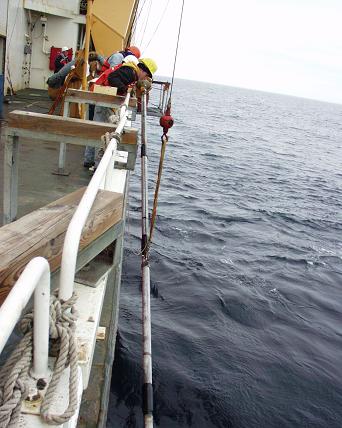
The core is lowered into the water. |
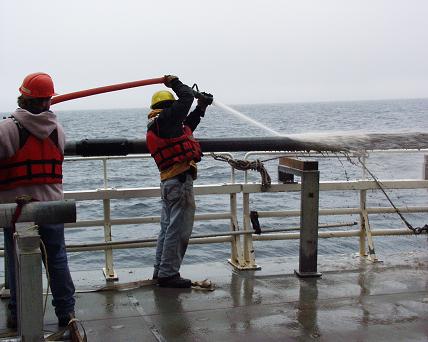
Washing mud off the core after it comes out. |
First, using special maps of the bottom of the ocean, a team of scientists has to decide where to place the core. Second, the core is long, about 40 feet. It’s not that easy to move a 40-foot section of steel pipe around. Third, it is VERY heavy. 5500 lbs of weight at the top of the pipe helps drive the pipe deep into the sea bottom. Fourth, the ship has to stay as still as possible so the core can go in straight and come out straight. Can you imagine keeping a 420-foot, 36 million pound ship still? Fifth, the sediment has to be cut into 1.5-meter sections (about 5 feet) and stored in a refrigerator to be studied in labs back on shore. Everyone must wear steel-toed shoes, a life vest, and a hardhat. |
| Once again, a team of people works together to make the coring possible. Two cranes help lift the long and heavy core in and out of the water. Coring technicians make sure the pipe and all its pieces are put together correctly. The ship’s pilot, with the ship’s computers, gently steer the ship to keep it in place. The technicians cut and label each section for storage and later study. Hopefully, the pictures help you understand. |
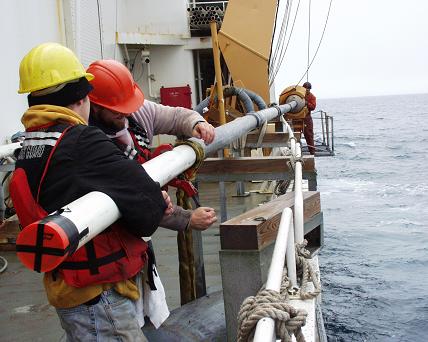
Cutting the core into 150cm (5ft) sections. Notice the end cap. |
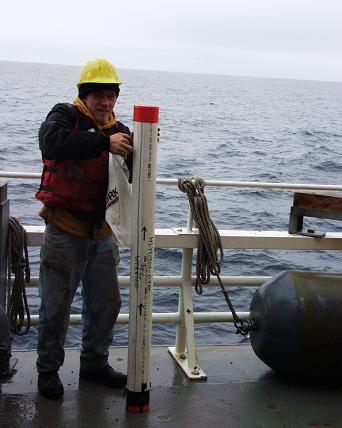
An historic 150cm of sediment from Baffin Bay. |
Just like life off the ship, things can go wrong. One coring try ended up with lots of water in the tube instead of dirt. The core hit a layer of gravel that stopped it from going deep into the ocean bottom. Darn! For another core, the ship’s bow thruster (an engine that helps keep the ship in one place) broke. Thanks to the skill of the pilot, and thanks to light winds, the coring team was able to get a great sample. |
| Who is interested in the layers of sediment at the bottom of Baffin Bay? Here is a short list of scientific areas that will study the earth’s history, geology, and biology with this very special dirt: sedimentology, mineralogy, geochemistry, geomorphology, micropaleontology, paleomagnetics, ocean engineering, and civil engineering. |

A bed of gravel like this blocked the core at one spot. |
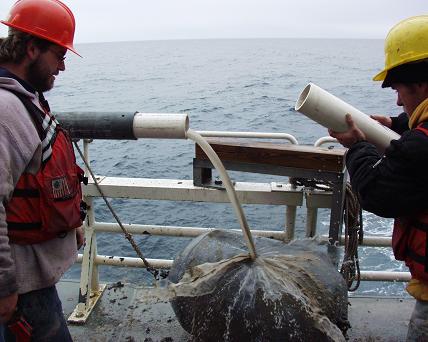
The core brought back water, not much sediment, this time. |
